
This series of online lessons will have students learning to make images using on and off.
- Subject:
- Applied Science
- Computer Science
- Material Type:
- Lesson Plan
- Provider:
- Code.org
- Provider Set:
- CS Fundamentals 2019-2020
- Date Added:
- 07/08/2021

This series of online lessons will have students learning to make images using on and off.

In collaboration with Common Sense Education, this lesson helps students learn to think critically about the user information that some websites request or require. Students learn the difference between private information and personal information, distinguishing what is safe and unsafe to share online.
Students will also explore what it means to be responsible and respectful to their offline and online communities as a step toward learning how to be good digital citizens.
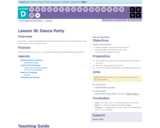
In this lesson, students will program their own interactive dance party. This activity requires sound as the tool was built to respond to music.
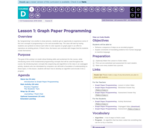
By "programming" one another to draw pictures, students get an opportunity to experience some of the core concepts of programming in a fun and accessible way. The class will start by having students use symbols to instruct each other to color squares on graph paper in an effort to reproduce an existing picture. If there’s time, the lesson can conclude with images that the students create themselves.
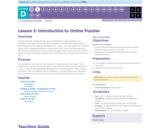
In this set of puzzles, students will begin with an introduction (or review depending on the experience of your class) of Code.org's online workspace. There will be videos pointing out the basic functionality of the workspace including the `Run`, `Reset`, and `Step` buttons. Also discussed in these videos: dragging Blockly blocks, deleting Blockly blocks, and connecting Blockly blocks. Next, students will practice their _sequencing_ and _debugging_ skills in maze. From there, students will see new types of puzzles like Collector, Artist, and Harvester when they learn the very basics of _loops_.
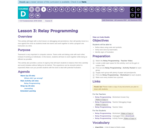
This activity will begin with a short lesson on debugging and persistence, then will quickly move to a race against the clock as students break into teams and work together to write a program one instruction at a time.
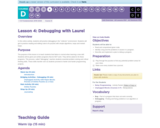
In this online activity, students will practice debugging in the "collector" environment. Students will get to practice reading and editing code to fix puzzles with simple algorithms, loops and nested loops.
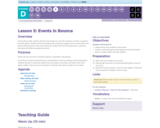
In this online activity, students will learn what events are, and how computers use them in programs like video games. Students will work through puzzles making the program react to events (like arrow buttons being pressed.) At the end of the puzzle, students will have the opportunity to customize their game with different speeds and sounds.
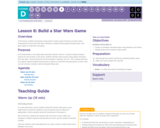
In this lesson, students will practice using events to build a game that they can share online. Featuring R2-D2 and other Star Wars characters, students will be guided through events, then given space to create their own game.
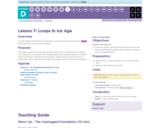
As a quick update (or introduction) to using loops, this stage will have students using the `repeat` block to get Scrat to the acorn more efficiently.
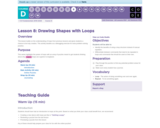
This lesson builds on the understanding of loops from previous lessons and gives students a chance to be truly creative. This activity doubles as a debugging exercise for extra problem-solving practice.
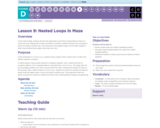
In this online activity, students will have the opportunity to push their understanding of loops to a whole new level. Playing with the Bee and Plants vs Zombies, students will learn how to program a loop to be inside of another loop. They will also be encouraged to figure out how little changes in either loop will affect their program when they click `Run`.

In this lesson, students will learn about accessibility and the value of empathy through brainstorming and designing accessible solutions for hypothetical apps.
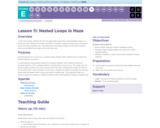
In this online activity, students will have the opportunity to push their understanding of loops to a whole new level. Playing with the Bee and Plants vs Zombies, students will learn how to program a loop to be inside of another loop. They will also be encouraged to figure out how little changes in either loop will affect their program when they click `Run`.
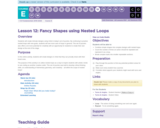
Students will create intricate designs using Artist in today's set of puzzles. By continuing to practice nested loops with new goals, students will see more uses of loops in general. This set of puzzles also offers a lot more potential for creativity with an opportunity for students to create their own design at the end of the stage.
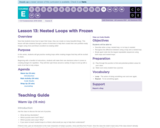
Now that students know how to layer their loops, they can create so many beautiful things. This lesson will take students through a series of exercises to help them create their own portfolio-ready images using Anna and Elsa's excellent ice-skating skills!

One of the most magnificent structures in the computer science world is the function. Functions (sometimes called procedures) are mini programs that you can use over and over inside of your bigger program. This lesson will help students intuitively understand why combining chunks of code into functions can be such a helpful practice.
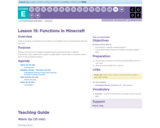
Students will begin to understand how functions can be helpful in this fun and interactive Minecraft adventure!
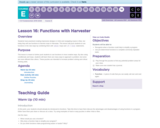
Students have practiced creating impressive designs in Artist and navigating mazes in Bee, but today they will use functions to harvest crops in Harvester. This lesson will push students to use functions in the new ways by combining them with `while` loops and `if / else` statements.
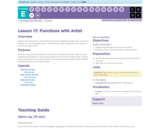
Students will be introduced to using functions with the Artist. Magnificent images will be created and modified. For more complicated patterns, students will learn about nesting functions by calling one function from inside another.